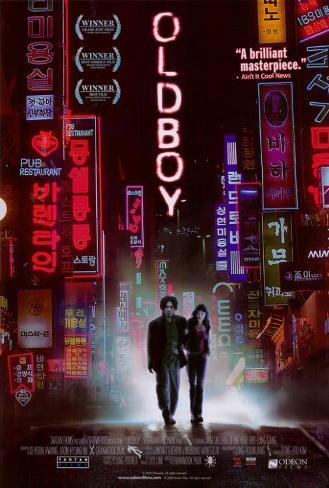After twenty years this film remains an astonishing sensory assault. The second entry in The Vengeance Trilogy of South Korea’s Park Chan-wook, which began with SYMPATHY FOR MR. VENGEANCE/Boksuneun naui geot (2002) and concluded with LADY VENGEANCE/Chinjeolhan geumjassi (2005). OLDBOY/Oldeuboi (2003) was the sensation of the 2004 Cannes Film Festival (although it had to settle for the Grand Prize, a.k.a. second place) and is said to have helped usher in the so-called torture porn film cycle.
Released in the US by the late Tartan Films, OLDBOY suffered from having its DVD release pushed back to 2005, when the “Asian Extreme” craze of the early aughts was nearing its end (and when most Asian film buffs already owned the film in import DVD form). It was, however, instrumental in securing Park’s fame in the west, where, after directing multiple American made film and TV projects, Park can be crowned the most successful Korean director of all time.
The story, based on a manga by Garon Tsuchiya and Nobuaki Minegishi, relates the ever-mutating account of Dae-su (Choi min-sik), a businessman who’s arrested one night for public drunkenness. He somehow ends up locked in a tiny apartment decorated with seriously ugly wallpaper, where every day he’s fed dumplings through a slit in the front door and rendered unconscious via gas sprayed into the room. After fifteen years of this a young woman appears in the room and hypnotizes Dae-su—hypnosis being a frequently returned-to motif—leading to his apparent “escape.”
Dae-su finds himself stuffed in a suitcase atop a building, where he meets a suicidal man. The resulting confrontation is violent and surreal, which adequately describes the remainder of the film.
Dae-su next fights several men and meets Mido (Kang Hye-jeong), a waitress who invites him back to her place. She lives in an apartment that’s not too dissimilar to the one in which Dae-su was imprisoned (furthering the conviction that this all might be a hypnotic fantasy taking place entirely in the protagonist’s head), albeit with even uglier wallpaper.
He succeeds in tracking down the location of his confinement and, in the film’s most famous scene, goes there to take on a hall-full of goons with a hammer—and wins. Things, meanwhile, appear to be going well with Mido, as she and Dae-su have sex, but then trouble arrives in the form of some gasmask wearing creeps. These guys narcotize Dae-su and Mido with gas (much like that to which Dae-su was subjected during his captivity) and then vacate the premises, leaving behind a giftwrapped box containing a severed hand. This points to past events that led to the imprisonment, events involving incest, disillusionment and a most untimely death.
Even after two decades, OLDBOY contains a plethora of shock, bewilderment, surprise and sheer amazement in scenes like the eating of a live octopus by actor Choi Min-sik (a Buddhist and a vegetarian, FYI), an attempted sexual assault on a toilet, a tongue amputation and not one but two close-up depictions of dental torture, coupled with a plethora of miscellaneous brutality. A shock-fest? Most certainly, but what ultimately registers is Park’s cinematic virtuosity, pulled off with a sense of playfulness that makes the film a joy to watch.
Listing all the filmmaking quirks on display would take far more space than I’ve got, but I’ll note a few. The overall look, attained with a “bleach bypass” that results in highly contrasty imagery, is unique and striking, with red and Green (which cinematographer Chung Chung-Hoon likens to “the color of rusty iron”) being the dominant filters. The camera movement is fluid and intense (the focus puller was allegedly so exhausted at the end of each shooting day he couldn’t lift a spoon), and punctuated by lively CGI-enhanced transitions (Park has particular fun with a bedside alarm clock whose changing numbers are given the extreme close-up treatment a la GROUNDHOG DAY); there is, in fact, more CGI to be found in OLDBOY than in any other Korean film of the aughts.
An acting showcase this stylistically oriented film isn’t, but the performers, particularly Choi Min-sik as Dae-su and Kang Hye-heong as Mido, look and feel at home in this twisted universe. The fight choreography of Kil-Yong Yang also deserves mention, particularly the justly famous single take hallway smackdown, leaving us with a film that satisfies as an action-fest in addition to a singularly warped artsploitation epic.
More recent developments in the OLDBOY saga include ZINDA (2005), an unauthorized Bollywood remake that was nearly the target of a copyright lawsuit by Showeast, an officially sanctioned Spike Lee directed 2013 English language version and the unvarified claim that OLDBOY inspired the 2007 Virginia Tech shooting. All three of those things can, and should, be summarily dismissed.
Vital Statistics
OLDBOY
Showeast/Tartan
Director: Park Chanwook
Producer: Kim Dong-Joo
Screenplay: Hwang Jo-Yun, Lim Joon-Hyung, Park Chanwook
Cinematography: Chung Chung-Hoon
Editing: Jae-beom Kim, Kim Sang-beom
Cast: Choi Mink-sik, Yoo Ji-tae, Gang Hye-jeong, Kim Byeong-Ok, Ji Dae-han, Oh Dai-su, Seung-shin Lee, Yoon Jin-seo, Oh Tae-kyung, Ahn Yeon-Seok, Il-han Oo, Young-hee Lee, Young-ae Kim, Mi Mi Lee, Jae-Duk Han, Jung Ae Kwak, San Kim, Chae-soo Jang, Seol-a Im, Syd Lim, Chang-hak Choi, Bi-Joon Shin, Seok-jae Seong, Choi Jae-sup

